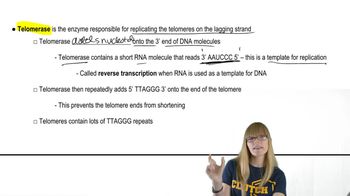Table of contents
- 1. Introduction to Genetics51m
- 2. Mendel's Laws of Inheritance3h 37m
- 3. Extensions to Mendelian Inheritance2h 41m
- 4. Genetic Mapping and Linkage2h 28m
- 5. Genetics of Bacteria and Viruses1h 21m
- 6. Chromosomal Variation1h 48m
- 7. DNA and Chromosome Structure56m
- 8. DNA Replication1h 10m
- 9. Mitosis and Meiosis1h 34m
- 10. Transcription1h 0m
- 11. Translation58m
- 12. Gene Regulation in Prokaryotes1h 19m
- 13. Gene Regulation in Eukaryotes44m
- 14. Genetic Control of Development44m
- 15. Genomes and Genomics1h 50m
- 16. Transposable Elements47m
- 17. Mutation, Repair, and Recombination1h 6m
- 18. Molecular Genetic Tools19m
- 19. Cancer Genetics29m
- 20. Quantitative Genetics1h 26m
- 21. Population Genetics50m
- 22. Evolutionary Genetics29m
7. DNA and Chromosome Structure
Eukaryotic Chromosome Structure
Problem 16c
Textbook Question
The accompanying chromosome diagram represents a eukaryotic chromosome prepared with Giemsa stain. Indicate the heterochromatic and euchromatic regions of the chromosome, and label the chromosome's centromeric and telomeric regions.
Do you expect the centromeric region to contain heterochromatin? Why or why not? <>
 Verified step by step guidance
Verified step by step guidance1
<Identify the regions of the chromosome: The diagram will typically show darker and lighter bands. The darker bands are usually heterochromatic regions, while the lighter bands are euchromatic regions.>
<Label the centromeric region: The centromere is often located at a constricted region of the chromosome and is crucial for chromosome movement during cell division.>
<Label the telomeric regions: These are located at the ends of the chromosome and protect the chromosome from deterioration.>
<Discuss the nature of the centromeric region: The centromeric region is generally expected to contain heterochromatin.>
<Explain why the centromeric region contains heterochromatin: Heterochromatin is tightly packed DNA, which is less transcriptionally active, providing structural stability and playing a role in chromosome segregation during cell division.>
Recommended similar problem, with video answer:
 Verified Solution
Verified SolutionThis video solution was recommended by our tutors as helpful for the problem above
Video duration:
2mPlay a video:
Was this helpful?
Key Concepts
Here are the essential concepts you must grasp in order to answer the question correctly.
Euchromatin and Heterochromatin
Euchromatin is a less condensed form of chromatin that is actively involved in transcription, making genes accessible for expression. In contrast, heterochromatin is tightly packed and generally transcriptionally inactive, often found in regions of the chromosome that are not expressed. Understanding the distinction between these two forms is crucial for identifying their locations on a chromosome diagram.
Recommended video:
Guided course

Chromatin
Centromere and Telomere
The centromere is the region of a chromosome where sister chromatids are joined and is essential for proper segregation during cell division. Telomeres are repetitive nucleotide sequences at the ends of chromosomes that protect them from degradation and prevent fusion with neighboring chromosomes. Recognizing these structures helps in labeling the chromosome accurately.
Recommended video:
Guided course

Telomeres and Telomerase
Chromatin Staining Techniques
Chromatin staining techniques, such as Giemsa staining, allow visualization of chromosomal structures by highlighting differences in chromatin density. This technique helps differentiate between euchromatin and heterochromatin based on their staining properties, which is essential for identifying regions of the chromosome in the provided diagram.
Recommended video:
Guided course

Chromatin

 7:10m
7:10mWatch next
Master Chromosome Structure with a bite sized video explanation from Kylia Goodner
Start learningRelated Videos
Related Practice



